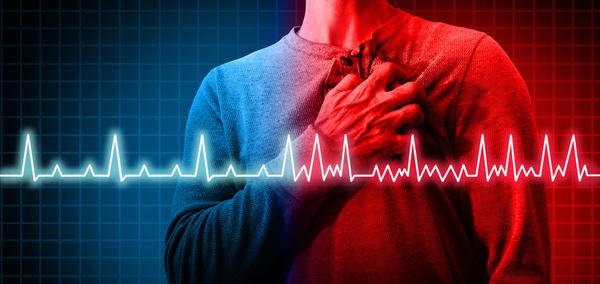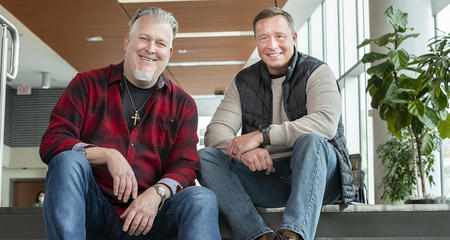
Cardiac Ablation for Atrial Fibrillation
Atrial fibrillation affects one in 18 people in the U.S. Froedtert & MCW electrophysiologists are addressing the prevalence of arrhythmia disorders with progressive cardiac ablation strategies to bring hearts — and lives — back into rhythm.

Atrial fibrillation accounts for more than 500,000 visits to the emergency department a year, according to an American Heart Association study, and affects one in 18 people in the U.S.
Electrophysiologists within the Froedtert & the Medical College of Wisconsin health network are addressing the prevalence of arrhythmia disorders with progressive cardiac ablation strategies to bring hearts — and lives — back into rhythm.
According to Marcie Berger, MD, electrophysiologist and MCW faculty member, the causes are different depending on the underlying nature of the arrhythmia.
Supraventricular arrhythmia, for instance, may be a congenital condition due to an electrical fault in the connection or muscle bridge between the atrium and ventricle.
“Atrial fibrillation or flutter — the most common problem we see — is often due to enlargement of the atrium; scar deposition in the atrium; the consequences of aging, valve disease, coronary artery disease, high blood pressure and sleep apnea; and a variety of other causes,” Dr. Berger said.
With ventricular tachycardia, the trigger may be areas of scarring from a heart attack, the more diffuse scar of dilated cardiomyopathy or other causes.
In other cases, no cause can be identified.
“Imaging doesn’t show an abnormality, but rather a group of cells that can cause a fast rhythm from the atria or ventricles, and we don’t have a clear explanation why people have these,” Dr. Berger said.
The first line of treatment has been medication with relatively safe drugs like beta-blockers. For arrhythmias that do not respond to this class of medications, physicians use stronger drugs that can have toxic side effects or are less well-tolerated.
Cardiac Ablation As an Earlier Option
“Ablation has come to the forefront earlier in the course of therapy as a potentially curative approach instead of medical therapy, which can be only marginally efficient or poorly tolerated,” Dr. Berger said. “Fixing the problem with one procedure is an attractive option.”
Arrhythmias affect a wide swath of the population, from healthy children to adults in their 90s. Some people have an otherwise normal heart structure, with a purely electrical problem. Young people who prefer not to take medication chronically might prefer ablation as a potentially permanent solution.
“Atrial fibrillation is becoming almost endemic,” Dr. Berger said. “Long-distance athletes may be prone to developing it, but it is more common with lung disease, sleep apnea, diabetes and obesity. These diseases and problems are becoming much more prevalent, and people are considering ablation to resolve their problems.”
Treating arrhythmias is more than just addressing the discomfort or anxiety they cause patients.
“Many rhythm disturbances are not benign,” Dr. Berger said. “Atrial fibrillation, for instance, can cause significant disability and symptoms. It can lead to heart failure, stroke or needing medication that can make people feel chronically fatigued.”
Ventricular tachycardia can cause fainting and also sudden death. In general, arrhythmia can place severe limitations on lifestyle and even longevity.
A Hot or Cold Burn
Ablation uses either a heat source (radio frequency energy) or cold source (cryothermal energy) to intentionally destroy or scar a localized area of cardiac tissue that is allowing errant electrical signals to cause abnormal rhythms.
“To have effective lesions that prevent tachycardia or atrial fibrillation, we need to have a full thickness injury or scar,” Dr. Berger said. “One of the reasons arrhythmias may reoccur after ablation is that we were unable to damage the tissue enough.”
Monitoring of electrical conduction in the heart during the procedure may show that an area has been blocked. But some of that tissue injury may not be permanent; it can recover and conduct electricity again.
The success rate for cardiac ablation depends on the kind of arrhythmia.
"For a young person with supraventricular tachycardia, it works 98% of the time,” she said. “The success rate of a single procedure for recent onset atrial fibrillation is 70-75%. Compare that to the success rate of 30% with drugs. Even if the patient needs a second ablation, it rises to 80-85%, which is much better.”
Often, a patient whose arrhythmia has been reduced by cardiac ablation will still need to remain on an anti-arrhythmia drug.
“But they can be placed on a safer drug,” Dr. Berger said. “Another outcome is that a patient still has atrial fibrillation, but it is reduced markedly. From a clinical standpoint, ablation still delivers a benefit.”
Better Tools and Techniques
Dr. Berger believes that both the techniques and the technologies of cardiac ablation have improved.
“The procedures have become shorter as we’ve become better at doing them,” she said. “We’ve developed better tools and catheters to perform these procedures. Fortunately, the risks of these procedures have decreased.”
While radio frequency energy is the primary source for treating atrial fibrillation, Froedtert & MCW electrophysiologists often use cryothermal ablation for early-stage disease.
“We deploy a balloon catheter infused with a coolant, which turns the balloon into an ice ball, essentially,” Dr. Berger said. “We often do that for the initial procedure because it’s faster and better tolerated by the patient. Infrequently, we use the cryo balloon if we need to ablate near other structures, as it’s less likely to do damage with cooling.”
Dr. Berger allayed concerns that ablation compromises the heart muscle.
“The area we’re damaging is small, and typically we’re delivering ablation to an area that’s already damaged and doesn’t have functional consequences for the heart as a muscle,” she said.
Often, electrophysiologists will have to ablate more than one area. In some cases, they will ablate the entire back wall around the left atrium, delivering a “box” lesion to effect electrical isolation. With ablation in the upper ventricles, a single burn often resolves the problem.
Mapping the Way
Throughout the procedure, electrophysiologists are recording electrical activity within the heart, attempting to induce a fast rhythm with pacing to find the pathway of abnormal electrical signals.
“We use 3-D mapping systems to reduce radiation exposure and to localize these problems,” Dr. Berger said. “They can make maps with thousands of points to clearly delineate electrical circuits. Three-dimensional mapping facilitates ablation of more complex problems, helping to create ultra-dense maps and pinpoint the problems.”
The Froedtert & MCW health network offers a variety of benefits to atrial fibrillation patients who opt for a cardiac ablation.
“We are experienced with complex patients, including complex cardiac patients with comorbidities like cancer, coagulation disorders and other problems,” she said.
With eight electrophysiologists on staff, the lab treats a high volume of patients. Patients have the advantage of an interdisciplinary team of electrophysiologists working together to determine the best approaches.
Our electrophysiologists communicate closely with referring physicians. If patients are not from the area and referring physicians are managing most of the follow-up care, physicians can reach Froedtert & MCW electrophysiologists via e-mails and pages. In addition, our contact points include five nurse practitioners dedicated to electrophysiology and six electrophysiology nurses.
“We’ve built up an experienced support staff who are very knowledgeable about the electrophysiology program, which makes it easy for referring physicians to have access,” Dr. Berger said.
For Our Referring Physicians:
Academic Advantage of Cardiac Ablation
The Froedtert & MCW health network gives patients and their referring physicians a distinct advantage.
Contact our physician liaison team for more information about cardiac ablation or if you would be interested in meeting with any of the electrophysiology team members.


